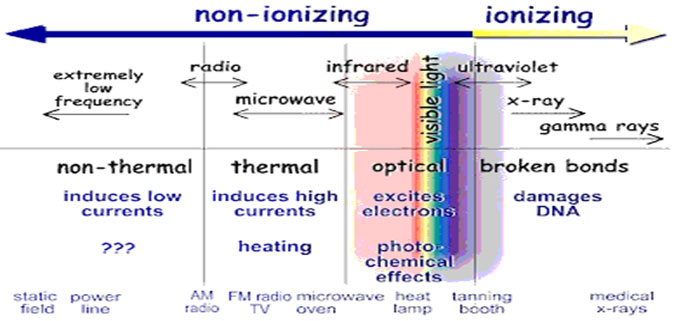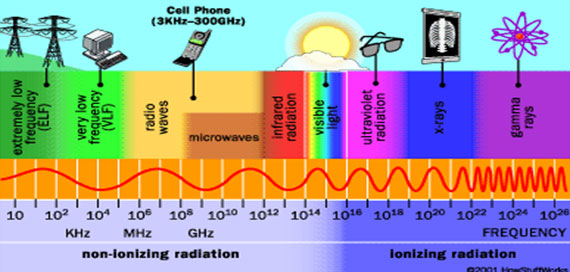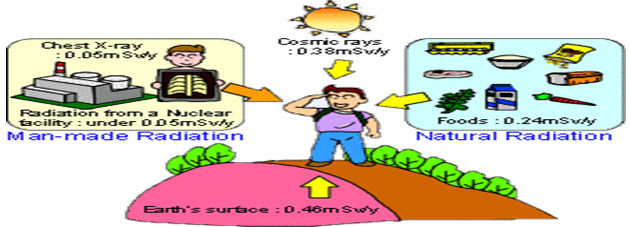Introduction
Radiation is a form of wave’s energy. It acts like electromagnet with electromagnetic waves and magnetic energy travels together through a chamber with various speed. Examples of radiation include UV rays from the sun, infrared, microwave and radio waves.
Almost everyday, our lives are exposed to radiation eg an exposure to sunlight, radioactive materials in the soil and stone, television, buildings, agricultural products, mining activities and also from coal minings.
Despite, radiation are used for medical purposes such as in x-ray taking, computed tomography (CT) scan, mammography, nuclear medicine, radiotherapy and Positron Emission Tomography (PET) Scan. It helps the doctor to identify diseases and detect its exact location, thus enable suitable treatment provided to treat the disease. For example, a radiotherapy procedure is used to destroy cancer cells.

Types of Radiation
There are two types of radiation:
- Ionizing Radiation (IR)It contains enough energy to produce a matter to become ionized. Ionization is a process to remove tightly bound electrons from atoms, thus creating ions. These unstable ions will then
interact with living tissues in human body to cause chemical reaction that is possible to cause biological tissue changes and affects the DNA or genetic matter. Alpha particle (?), Beta particle (?) and x-ray (?) are examples of ionizing radiation. - Non-Ionizing Radiation (NIR)Non-ionizing radiation does not have enough energy to ionized matter or substance. It can caused heat but does not affect the tissues cells. Radiofrequency, visible light and microwave are the example of non-ionizing radiation. Even the non-ionizing radiation has enough energy; it will not give any impact to the living tissue unlike ionizing radiation.
Classifications of Radiation
Radiation wave can be classified according to their energy, frequency and wavelength. Radiation wave with low energy, low frequency but with longest wavelength is called as electromagnetic wave. Examples of electromagnetic wave are TV wave, Radio wave, phone signal and microwave. However, research have shown that these waves is not harmful because electromagnetic wave is a non ionizing radiation.
Infrared is an example of longest wavelength compared to other electromagnetic waves. It is closely followed by visible light and an ultraviolet. Radiation wave with high energy and frequency is part of ionizing radiation as seen in an x-ray and gamma ray. Higher dose can be harmful to our general health as these limit of ionizing radiation exceeds normal human dose required.
Source of Radiation
- Natural sources as from Earth and cosmic ray can produce gamma ray
- Artificial sources: Used widely in medical field (X-ray, CT Scan, Nuclear Medicine and Radiotherapy)
- Others Sources: nuclear fuel cycle
Radiation Effects
The effect of Radiation exposure on health of may be immediate or delayed. Its severity or type affected is depends on the duration and amount of exposure received by the body. Two types of effects will occur; stochastic effect and deterministic effect.
Stochastic effect occurs to those who are exposed to radiation with small amount continuously with no limits. With an increased levels of exposure, the health effects is more likely to occur. This is called as delayed effect. Example is uncontrolled growth of cancer cells in the human body.
Deterministic effect is an immediate effect. The radiation exposure effect usually appear quite fast. Usually, the amount of the exposure is high thus giving the effect immediately to the body. Skin burn is an examples of deterministic effect. The symptoms of deterministic effect cannot be traced if the dose is below threshold level 0.5 mSv (Sievert).
However, it is not easy to identify radiation effect because even if one has been exposed to little amount of radiations, Stochastic effect such as developing cancer cells rapidly may still occur. These effects may appear only later in life perhaps after decades.
References
- Radiation Safety Second Edition 2002, MINT
- IAEA Publications
- Radiation: Basis of Human Life, Wan Saffey Wan Abdullah, MINT
| Last Reviewed | : | 8 October 2014 |
| Writer / Translator | : | Mohd Khairudin b. Mohd Samsi |
| Accreditor | : | Nik Mohamed Hazmi b. Nik Hussain |










